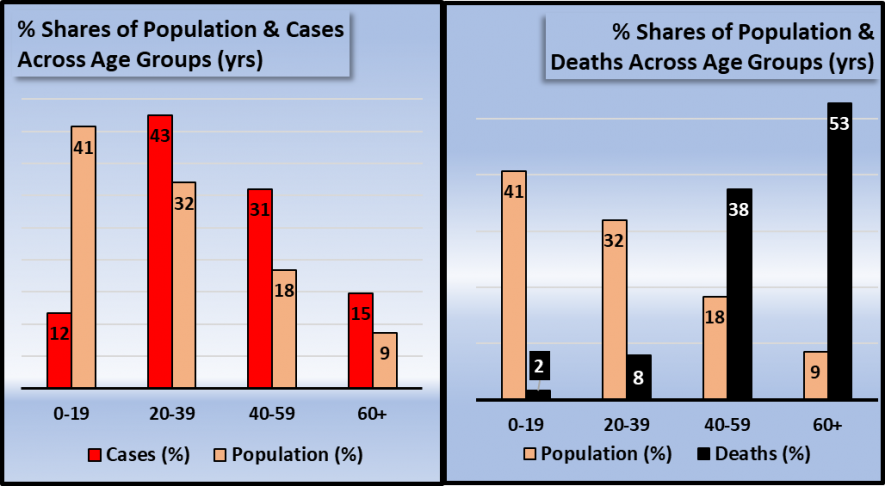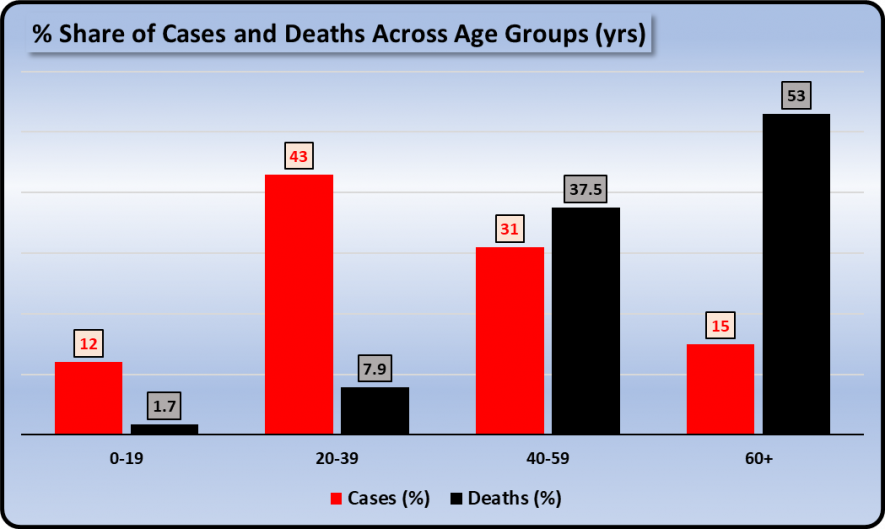Understanding India’s Low COVID-19 Death Rate

Image Courtesy: Deccan Herald
India continues to reel under the COVID-19 pandemic, with total confirmed cases till August 19 nearing 28 lakh (2.8 million) and deaths of over 53,000 persons. Perhaps in an attempt to highlight the silver lining, or maybe to escape its grim responsibility, the government has been highlighting recoveries from the disease (over 20 lakh or 2 million), the increasing number of tests done (nearly 3.2 crore or 32 million) and a curious emphasis on the fatality rate. Prime Minister Modi has repeatedly said that India has a lower COVID-19 death rate than many other countries, implying that the government has done its job well.
This assertion is true: as of August 19, the fatality rate has slipped to just 1.91%. The world average is around 3.5%, but many advanced countries have much higher death rates, like Italy (13.5%), UK (13%), US (3.1%), China (5.3%). So, what is happening? Why has India such a low level of deaths?
The fatality rate, or more correctly, the ‘case fatality rate’ or CFR is the share of deaths in all confirmed cases. So, India’s CFR means roughly, every two persons out of hundred infected ones die.
Also read: COVID-19: Case Fatality Rate in South Indian States Much Lower Than National Average
In an eye-opening study published last week by the US based National Bureau of Economic Research (NBER), researchers have analysed the low fatality rate and found that the average CFR for India conceals widely differing age specific CFRs – in younger age groups, deaths are much lower while in the older ones, much more. Additionally, they have raised serious doubts about the way CFR is calculated by dividing deaths by cases (taken as a percentage) for a specific day. They argue – persuasively – that with an average time between infection and death being 10-18 days according to different studies, the CFR should be calculated by taking deaths as a share of new infections 10 to 18 days ago, and not on the day of death taking place. With cases rising very rapidly, the researchers show that this would lead to much higher CFR than currently announced.
Cases and Deaths Across Different Ages
It is well known that the novel coronavirus that causes COVID-19 affects older people more severely, because they have a weakened immune system and may suffer from other chronic diseases. India has a young population, with 41% of people 19 years or below in age, and nearly two thirds of the population below 39 years. As shown in the chart below, most of the confirmed cases are in the 20-39 or 40-59 years age groups. In fact, 55% of the cases are in persons below 39 years age. Clearly, the disease has spread much more in the relatively younger population, not surprisingly, because they make up the bulk of the population and also, because they are the ones who will go out more for work, thus getting exposed more.

In the panel on the right of the chart above, deaths are shown across age groups. Here one sees that deaths are concentrated in the older age groups. The younger 74% of the population (up to 39 years old) has only 10% of all deaths due to COVID-19, while the 60+ years age group, making up just 9% of the population has a jaw dropping share of 53% of all deaths.
The NBER study researchers have used the official data on age wise cases and deaths released last by the Ministry of Health on July 8, and interpolated it with an earlier study to get 10-year age groups. For clarity, these are shown in charts here in 20-year age groups. Strangely, the health ministry reveals age specific data only intermittently and randomly, leaving no room to build a robust dissection that would help the country fight the pandemic better.
Cases & Deaths: Both Represent Failures of Govt Strategy
The relationship with age is clear – more cases in younger ages (because they are more in numbers and are exposed more) but much more fatality in older ages (they are more vulnerable).
To make this clearer, and bring out some additional dimensions, look at the chart below which compares cases with deaths across age groups. In the 60+ years age group, there are just 15% of India’s confirmed cases but 53% of deaths due to COVID-19. In the next younger age group (40-59 years) the two aspects are more balanced – 31% of all cases and 37.5% of all deaths. In the still younger age group of 20-39 years, the skew is reversed. This group has 43% of all cases but only about 8% of all deaths. The youngest age group of 0-19 years has a similar skew – 12% of all cases but just short of 2% of all deaths.

Can the government claim any achievement in this distribution of cases and deaths? Number of cases represents outcome of the preventive arm of government strategy to fight the virus. Clearly, it has failed in prevention because the number of cases has steadily been rising all through the past six months, more rapidly in the recent weeks. And, it has affected those who have to go out more because the government has obstinately refused to provide economic support to those who can’t sit idle – the poorer sections.
Number of deaths is the outcome of the other arm of government strategy – adequate, affordable, accessible medical care, including critical care. Clearly, in this too, there is failure of government strategy. Either because medical care was not accessible or affordable, the number of people in older age groups who had to die is staggeringly higher than expected. It didn’t have to be like this: quick and effective medical care could have saved more lives, especially of the older age group.
The use of case fatality rate to claim that India is doing well in its response to COVID-19 and that somehow the Modi government has planned the whole thing like this is a travesty of reasonable thinking and calls for a leap of imagination. As shown above, the lower death rate is a combination of the younger age of the population and that the countrywide average hides the high death rates among older populations. This is not just to call out these tricks of the trade – policy interventions are dependent on how you collect, analyse and interpret data. Misleading data usage can have very serious and damaging consequences for the people – as this COVID-19 pandemic is showing to India.
Also read: Misleading Death Rate: Underestimating the Crisis?
Get the latest reports & analysis with people's perspective on Protests, movements & deep analytical videos, discussions of the current affairs in your Telegram app. Subscribe to NewsClick's Telegram channel & get Real-Time updates on stories, as they get published on our website.























